Doom's 'Nightmare' graphics: image quality compared and benchmarked
"Requires" 5GB of VRAM but only looks slightly better.
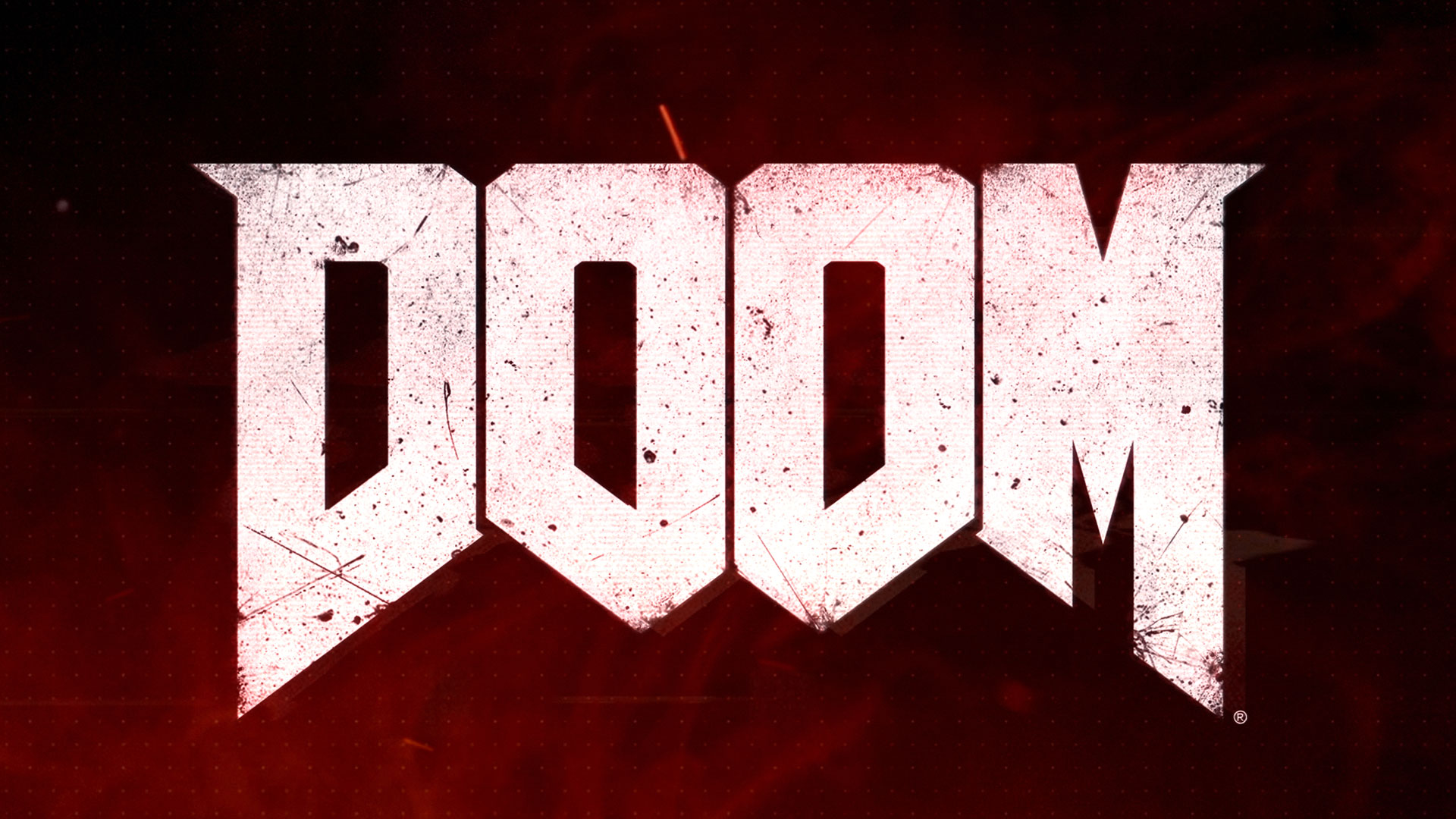
Doom's Nightmare graphics
You have to hand it to id Software; if there's one thing they know how to do well, it's Doomed space marines killing demons on Mars. They're back again, and this fourth (depending on how you want to count) iteration comes decked out in the latest id Tech 6 engine graphics. It's the best looking Doom game to date, no doubt about that… but just what sort of hardware are you going to need to run this beast? And what about the new "Nightmare" image quality setting?
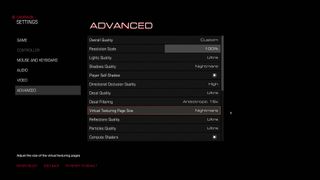
Let's start with the Nightmare quality, because that's easiest. It's not a preset, and there are only two options that you can set to "Nightmare," Shadows Quality and Virtual Texturing Page Size. And if you want to enable those settings, you'll need to have a pretty potent graphics card, because:
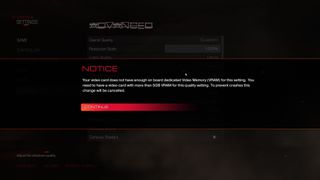
5GB is an odd amount of VRAM to require, but presumably that's to ensure the game engine has enough space for all the textures, frame buffers, Z buffer, and whatever else it needs. If you're running on any GPU with less than 5GB VRAM, you're going to see the above warning. You can get around it by starting the game with "+menu_advanced_AllowAllSettings 1", but if they're serious about crashes, you're probably best off leaving it alone. But we threw caution to the wind and retested performance.
The list of graphics cards with more than 5GB of VRAM is pretty exclusive. There's the original GTX Titan, with 6GB, plus the derivative Titan Black and Titan Z (both with 6GB per GPU). The more recent GTX Titan X (12GB) and the similar performing GTX 980 Ti (6GB) also qualify. And naturally, the upcoming GTX 1080 and GTX 1070 (both 8GB cards) will also work. On the AMD side, the only consumer GPUs that currently have enough VRAM are the R9 390X (8GB), R9 390 (8GB), and the R9 290X 8GB (which wasn't a common card, though a few exist). There are also a few notebook GPUs with 6GB or more VRAM.
Note that while certain configurations may have 6GB or more total VRAM, the requirement appears to be on a per GPU basis, so CrossFire or SLI setups with 8GB total VRAM don't qualify. Anything outside of those cards, and you're "limited" to mere Ultra quality.
You're probably wondering what the payoff is in terms of image fidelity. First, here's what Doom looks like without enabling Nightmare quality:
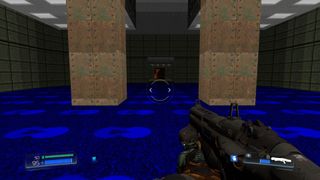
Hmmm… wait a minute. That doesn't seem quite right. All joking aside, while the difference is noticeable in still shots, as you'll see below, it's not a night and day sort of change. Here are five samples, starting with Ultra + Nightmare and followed by the four main presets (Ultra, High, Medium, and Low):
The biggest gaming news, reviews and hardware deals
Keep up to date with the most important stories and the best deals, as picked by the PC Gamer team.
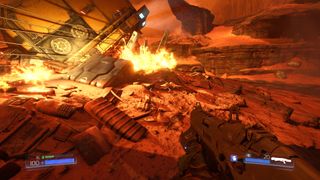

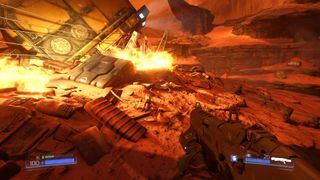
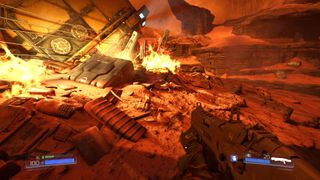
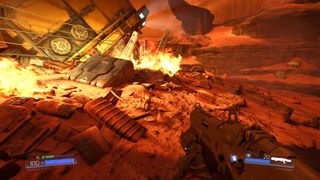
These shots are from outside, and there's blowing dust and debris plus the animated fire, so don't get distracted by variations there. Instead, pay close attention to the level of detail on the shadows, because that's the primary change. Texture quality also drops a bit, and in other scenes you'll see a drop in the rendering distance for certain effects. Rather than stuff a bunch more images here, we've put additional images on page two, but now, let's talk frame rates.
Doom performance preview
Given the relatively slight changes in appearance, the other question you're no doubt asking is how Doom runs. We haven't completed extensive testing (yet), but here's a quick look at a few different graphics cards, specifically Nvidia's (reference) GTX 980 Ti and GTX 980, and AMD's R9 390 (Sapphire) and R9 Fury X (reference). The Nvidia GPUs were tested using the latest 365.19 drivers, and the AMD GPUs used the Crimson 16.5.2.1 Hotfix drivers—both driver sets are supposed to be optimized for Doom. (Note: we've updated the graphs and drivers for AMD since originally posting this article.)
We used our standard test bed, which runs an overclocked 4.2GHz i7-5930K with 16GB G.Skill DDR4-2666 RAM. For test settings used the Ultra preset at 1920x1080, 2560x1440, and 3840x2160. We also ran the Low preset and Ultra + Nightmare (and 16xAF), both at 3840x2160. And no, Doom didn't crash during our testing, even on 4GB GPUs with Nightmare quality enabled, though we didn't play for more than 15 minutes.
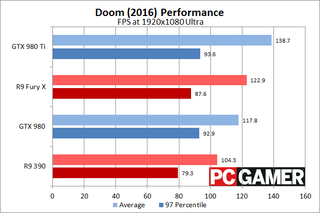
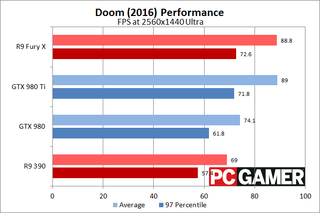
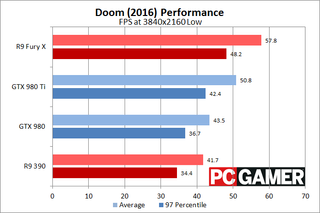
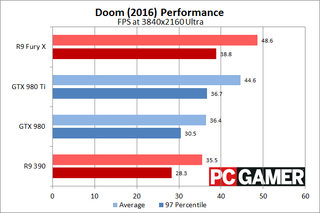
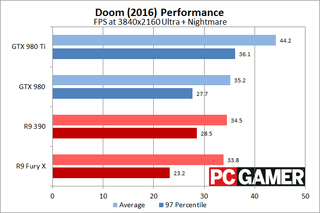
Nvidia has their usual lead with the 980 Ti at 1080p, but that turns into a tie at 1440p, and at 4K the Fury X takes a clear lead. Part of that is almost certainly thanks to the gobs of memory bandwidth the Fury X has (512GB/s vs. 336GB/s on the Ti), but it's still noteworthy. The GTX 980 also leads the R9 390, but it's a more expensive card (even with the current drop in price), so perhaps that's expected. Anyway, it's not just about memory bandwidth since the 980 has 224GB/s compared to 384GB/s for the 390.
Update: We have retested the R9 390 with the 16.5.2.1 drivers and changed the above analysis. Initially, Hawaii-based GPUs performed very poorly using the 16.5.2 drivers, and it took a few extra days for AMD to iron out the kinks (over a weekend, no less).
And then there's the Ultra + Nightmare quality. It may not look substantially different, but at least it doesn't tank performance too badly...except for the Fury X. The 980 Ti loses about 1-2 percent in performance is all, the 980 and 390 drop about 3 percent, but the Fury X takes a 30 percent hit. Maybe we'll see a 16.5.2.2 hotfix, as it doesn't seem to be a problem for the 4GB 980 card. Outside of the Fury X (and Fury and Nano, if you're wondering), Nightmare mode isn't a problem, at least on cards that have a chance of running such settings in the first place; that's good news of a sort, but there's bad news as well.
If you're not running high-end hardware, notice just how little performance difference there is between the 4K Low and 4K Ultra setting. We've seen many games where the difference between Ultra and High quality can be a 50 percent improvement in frame rates. Doom mostly doesn't care too much about the quality setting, gaining only 15-20 percent in performance by going from Ultra to Low quality (granted, at 4K).
If that sounds significant, consider that the increase in performance going from Ultra to Low in other games (e.g., Shadow of Mordor) can be 100% or more. Basically, Doom cares far more about your resolution than it does about the quality setting—which isn't too surprising if you look at those above image quality comparisons. We'll be looking into this more with additional testing.
At Ultra + Nightmare quality, Doom looks quite good; at Low quality, it still looks pretty good. But if you're running hardware that struggles to hit 60 fps at 1920x1080, it probably means you'll have to drop the resolution rather than adjusting rendering quality.
Jarred's love of computers dates back to the dark ages when his dad brought home a DOS 2.3 PC and he left his C-64 behind. He eventually built his first custom PC in 1990 with a 286 12MHz, only to discover it was already woefully outdated when Wing Commander was released a few months later. He holds a BS in Computer Science from Brigham Young University and has been working as a tech journalist since 2004, writing for AnandTech, Maximum PC, and PC Gamer. From the first S3 Virge '3D decelerators' to today's GPUs, Jarred keeps up with all the latest graphics trends and is the one to ask about game performance.
Most Popular



